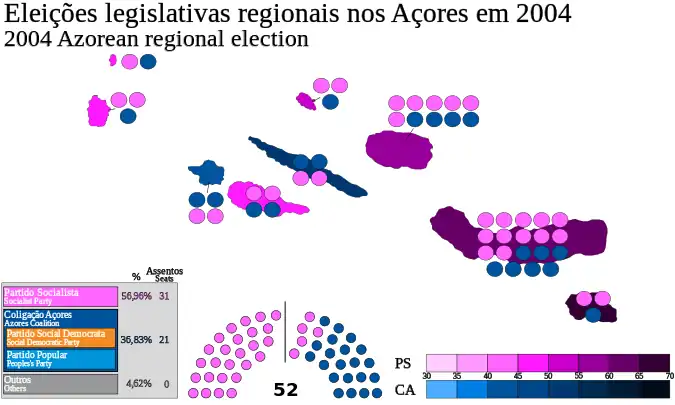2004 Azorean regional election
The Azores Regional Election, 2004 (Portuguese: Eleições Regionais dos Açores, 2004) was an election held on 17 October 2004 for the legislative assembly and government of the Portuguese autonomous region of the Azores, in which the Socialist Party, under the leadership of Carlos César won 57% of the votes, and got an absolute majority, for the 2nd consecutive turn. The Social Democratic Party ran in a coalition with the People's Party, called Azores Coalition, but was massively defeated gathering just 37% of the votes.[2]
| |||||||||||||||||||||||||||||||
52 seats to the Legislative Assembly of Azores 27 seats needed for a majority | |||||||||||||||||||||||||||||||
|---|---|---|---|---|---|---|---|---|---|---|---|---|---|---|---|---|---|---|---|---|---|---|---|---|---|---|---|---|---|---|---|
| Turnout | 55.2% | ||||||||||||||||||||||||||||||
| |||||||||||||||||||||||||||||||
| |||||||||||||||||||||||||||||||
Voter turnout increased, for the first time since the 1992 election, with 55.2% of the electorate casting their ballot on election day.
Background
In the Azores, there were 52 seats in the Regional Parliament in dispute, the same of the previous election, in 2000. The seats were distributed by the 9 islands of the archipelago proportionally to the population of each island; however, each island is entitled to at least two members of parliament.
Political parties
A total of 7 parties and/or coalitions ran in these elections. The parties/coalitions listed on the voting ballots were the following:
- Left Bloc (BE);
- Earth Party (MPT);
- Democratic Party of the Atlantic (PDA);
- People's Monarchist Party (PPM);
- Socialist Party (PS), leader Carlos César;
- Social Democratic Party / People's Party (PSD/CDS–PP) Azores Coalition (CA), leader Victor do Couto Cruz
- Unitary Democratic Coalition (CDU);
Results
For a third consecutive term, the Socialist Party won the regional election in Azores, increasing its share of the vote from 49% to 57%, and re-electing Carlos César to the presidency of the Regional Government. César and his party obtained an absolute majority with 31 of the assembly's 52 seats.[3]
The Social Democrats and the People's Party contested these elections in a joint coalition called "Azores Coalition". The coalition achieved a very disappointing result, polling 20% below the Socialists. The PSD/CDS-PP coalition only won 37% of the votes, but was able to increase the number of parliament members to 21, against the combined total of 20 both parties had since 2000. In fact, the bad result from this PSD/CDS-PP coalition was one of the reasons PSD and CDS didn't contest, in a coalition, the 2005 general elections.[4] Due to the strong bipolarization of the race, both PS and PSD/CDS-PP gathered a total of almost 94% of the votes, and due to the application of the Hondt election model in the nine islands, the smaller parties were severely punished. The Unitary Democratic Coalition (CDU), led by the Portuguese Communist Party (PCP), saw their share of vote reduced by almost half and they lost all representation in the regional parliament. The Left Bloc also suffered a setback by polling below 1%.
The People's Monarchist Party, the Earth Party and the Democratic Party of the Atlantic also failed to make any inroads.
Summary of votes and seats
| Parties | Votes | % | ±pp swing | MPs | MPs %/ votes % | |||||
|---|---|---|---|---|---|---|---|---|---|---|
| 2000 | 2004 | ± | % | ± | ||||||
| Socialist | 60,140 | 56.97 | 30 | 31 | 59.62 | 1.05 | ||||
| Azores Coalition (PSD / CDS–PP) | 38,883 | 36.84 | 20 | 21 | 40.38 | 1.10 | ||||
| Democratic Unity Coalition | 2,942 | 2.79 | 2 | 0 | 0.00 | 0.0 | ||||
| Left Bloc | 1,022 | 0.97 | 0 | 0 | 0.00 | 0.0 | ||||
| Earth | 369 | 0.35 | — | — | 0 | — | 0.00 | — | 0.0 | |
| People's Monarchist | 293 | 0.28 | — | — | 0 | — | 0.00 | — | 0.0 | |
| Democratic Party of the Atlantic | 248 | 0.23 | — | — | 0 | — | 0.00 | — | 0.0 | |
| Total valid | 103,897 | 98.43 | 52 | 52 | 100.00 | — | ||||
| Blank ballots | 879 | 0.83 | ||||||||
| Invalid ballots | 780 | 0.74 | ||||||||
| Total | 105,556 | 100.00 | ||||||||
| Registered voters/turnout | 191,127 | 55.23 | ||||||||
| Source: Comissão Nacional de Eleições | ||||||||||
Distribution by constituency
| Constituency | % | S | % | S | Total S |
|---|---|---|---|---|---|
| PS | CA | ||||
| Corvo | 49.4 | 1 | 36.1 | 1 | 2 |
| Faial | 39.8 | 2 | 40.2 | 2 | 4 |
| Flores | 46.2 | 2 | 35.9 | 1 | 3 |
| Graciosa | 52.7 | 2 | 44.3 | 1 | 3 |
| Pico | 49.4 | 2 | 46.3 | 2 | 4 |
| Santa Maria | 68.7 | 2 | 25.5 | 1 | 3 |
| São Jorge | 44.3 | 2 | 50.7 | 2 | 4 |
| São Miguel | 65.6 | 12 | 33.8 | 7 | 19 |
| Terceira | 59.1 | 6 | 37.0 | 4 | 10 |
| Total | 57.0 | 31 | 36.8 | 21 | 52 |
| Source: Comissão Nacional de Eleições | |||||
Maps
 Map showing island constituencies won by political parties.
Map showing island constituencies won by political parties.
References
- PSD: 32.5%, 18 seats; CDS-PP: 9.6%, 2 seats.
- Maioria Absoluta nos Açores, Correio da Manhã, 17 October 2004. Retrieved 18 June 2018.
- Os Senhores das Ilhas, Correio da Manhã, 17 October 2004. Retrieved 18 June 2018.
- As eleições e a Coligação, Correio da Manhã, 24 October 2004. Retrieved 18 June 2018.
See also
- 2004 Madeira regional election
